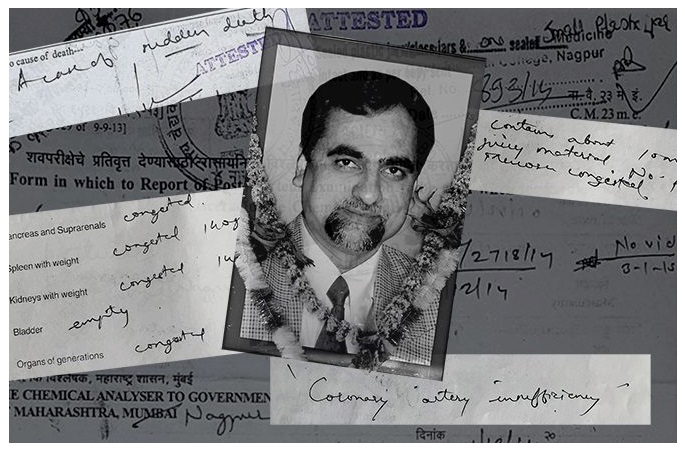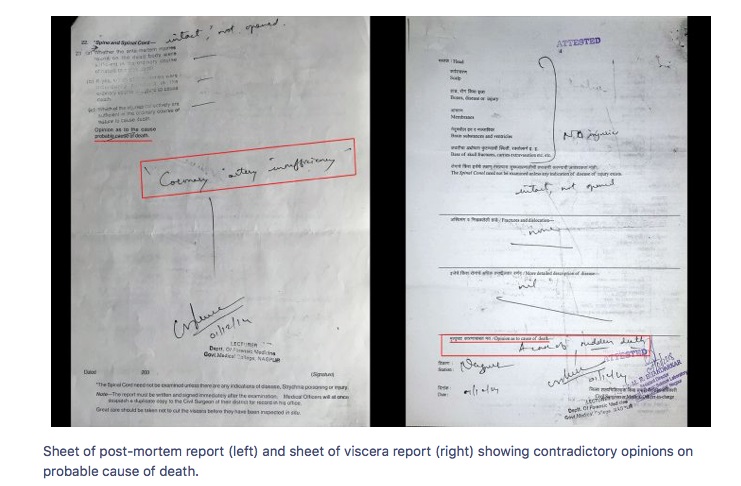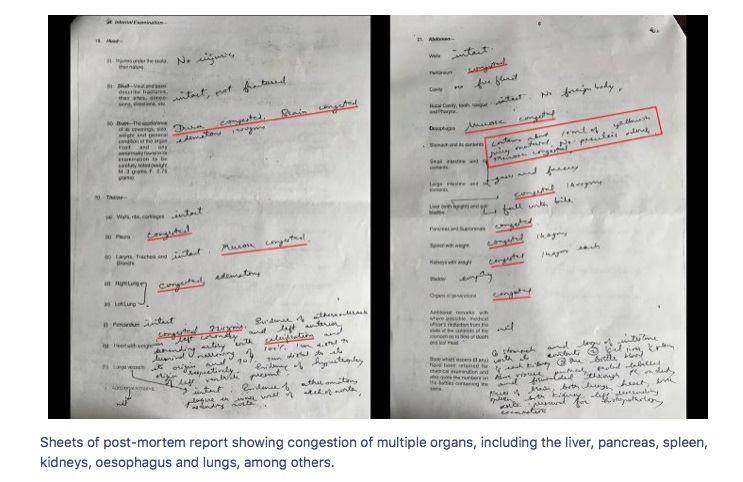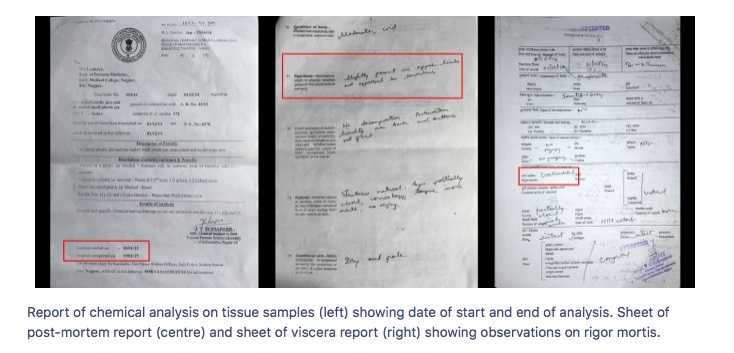Exact texts from Caravan has been reproduced :

After examining medical documents pertaining to the death of the judge Brijgopal Harkishan Loya, one of India’s foremost forensic experts, Dr RK Sharma, the former head of the Forensic Medicine and Toxicology Department at the All India Institute of Medical Sciences in Delhi, and the president of the Indian Association of Medico-Legal Experts for 22 years has dismissed the official claim that Loya died of a heart attack. According to Sharma, the documents show signs of possible trauma to the brain, and even possible poisoning.
Sharma spoke to The Caravan after studying Loya’s post-mortem report and related histopathology report, a report that accompanied samples of Loya’s viscera that were sent for chemical analysis, and the results of the chemical analysis. Some of these documents have been procured through Right to Information applications, and others have been submitted to the Supreme Court by the government of Maharashtra in support of a report by Maharashtra’s State Intelligence Department that concludes there is no cause for suspicion regarding Loya’s death. Sharma’s expert opinion contradicts this conclusion.
“There is no evidence of myocardial infarction in the histopathology report,” Sharma said. “The findings in this report have no suggestion of a heart-attack. They show changes, but not a heart attack.”

Sharma observed, “The post-mortem report also says that calcification is observed in the vessels. Where there is calcification, there is no heart attack. Once the vessels have calcified they will never block the flow of blood.”
Loya is reported to have complained of feeling unwell at about 4 am on the night of his death, and was declared dead at 6.15 am. “So that means two hours,” Sharma said. “If one is alive for more than 30 minutes after the symptoms [of a heart attack] show, the condition of the heart will have clear changes. No clear changes can be seen here.”
The post-mortem report states that the probable cause of death was “coronary artery insufficiency.” Sharma said that “there are changes observed in heart in these documents, but none of them are conclusive enough to show ‘Coronary Artery Insufficiency.’ Every patient who goes for a bypass surgery will have these symptoms.”
“More importantly, dura is congested according to the post-mortem report,” Sharma added. “Dura mater is the outermost layer that surrounds our brain. It is damaged in cases of trauma, which indicates some kind of an assault on the brain. A physical assault.”

Dr Anuradha Biyani, Loya’s sister and a medical doctor in the service of the Maharashtra government, told The Caravan earlier that, when she saw her brother’s body for the first time after his death, “there were bloodstains on the neck at the back of the shirt.” Biyani maintains a diary, and in an entry from the time of Loya’s death she recorded that “there was blood on his collar.”
Sarita Mandhane, another of Loya’s sisters, had also mentioned “blood on the neck” when she spoke to The Caravan, and that “these was blood and an injury on his head … on the back side.” Harkishan Loya, the judge’s father, told The Caravan that he remembered “bloodstains on the clothes.”
Among the state of Maharashtra’s submission to the Supreme Court is a bill in Loya’s name from Nagpur’s Meditrina hospital, where the judge was declared dead. While Meditrina officials maintain that Loya was brought in with heart problems, this document inexplicably lists “neurosurgery” as a billed item.
The post-mortem report does not record precisely how much congestion of dura was observed. Sharma said he found it strange that, “the reason why dura is congested is not written.”
“There is a possibility of poisoning,” Sharma continued, looking at the post-mortem report. “Every single organ is congested.” The organs recorded as “congested” in the report include the liver, pancreas, spleen, kidneys, oesophagus and lungs, among others.
The findings of the chemical analysis on Loya’s viscera samples, submitted 50 days after the judge’s death, did not identify any poison. The analysis was performed at the Regional Forensic Science Laboratory in Nagpur. It is recorded as having started on 5 January 2015 36 days after Loya’s death, on the night intervening between 30 November and 1 December 2014—and finished 14 days later, on 19 January 2015. “Why did it take so long for the analysis,” Sharma asked. “It generally takes a day or two [to complete the analysis].”

The chain of custody of Loya’s viscera sample appears to have been broken in the aftermath of the post-mortem. According to documents submitted to the Supreme Court by the state of Maharashtra, a zero-FIR regarding Loya’s death was first registered at Nagpur’s Sitabuldi police station. The Sitabuldi station arranged for the post-mortem, conducted at the Government Medical College in Nagpur from 10.55 am to 11.50 am on 1 December. The samples for chemical analysis are collected at the same time. For reasons that have not yet been made clear, the FIR was then transferred to Nagpur’s Sadar police station, where records show that it was registered at 4pm. It was the Sadar station that dispatched Loya’s tissue samples for analysis with the necessary letter. It is not clear where, and with whom, Loya’s tissue samples were in the hours between the post-mortem and the registration of the FIR at the Sadar station, or under whose supervision they were handed over to the Sadar station. Nor has it been made clear why the Sitabuldi station did not send the samples to the forensic laboratory right after the post-mortem was done.
In addition, there is no consensus on the condition of Loya’s body and the probable cause of Loya’s death as recorded in the post-mortem report and the report that accompanied Loya’s viscera samples when these were sent for analysis—despite the fact that the latter is meant to be based entirely on the former. In a field titled “rigor mortis,” meant to record how stiff a body is at the time of inspection, the post-mortem report states, “slightly present in upper limbs [and] not appeared in lower limbs.” The viscera report, under the same field, says that rigor mortis is “well marked.” Rigor mortis could not have been “slightly present” and “well marked” at the same time. In a field titled “opinion as to the probable cause of death,” the post-mortem report states, “Coronary artery insufficiency.” Under the same field, the viscera report and notes, “A case of sudden death.” In a field titled “Story of case,” the viscera report states, “A case of natural death,” with the words “natural death” underlined and yet a report of accidental death had earlier been registered at the Sitabuldi police station before it sent Loya’s body for a post-mortem.
Both the post-mortem report and the viscera report were prepared at the Government Medical College in Nagpur. The form used for the viscera report, obtained via a Right to Information application, clearly states that the information in it must be based on the post-mortem, and must be prepared immediately after the post-mortem by the same doctor who conducted the procedure. The form in Loya’s case, filled in by the forensic department of the Government Medical College, is titled “Form in which Report of Post-mortem Examination to be used when forwarding Viscera to the Chemical Analyser.” A doctor who works in the forensic department at AIIMS in Delhi confirmed that the standard procedure is to “copy the information in the post-mortem to the form” that accompanies viscera sent to a chemical analyser. Sharma said the same thing.
In Loya’s case, both the post-mortem and the viscera reports are signed by Dr NK Tumaram, a lecturer at the Government Medical College and yet the same doctor, in reports meant to be prepared almost simultaneously, has furnished clearly contradictory information, even on something as important as the probable cause of death. When The Caravan contacted Tumaram, he said he could not speak about the case since it is being heard in court.
Loya was 48 years old at the time of his death, did not smoke or drink, and had no personal or familial history of heart ailments. “Our parents are 85 and 80 years old, and are healthy with no cardiac history,” Anuradha Biyani earlier told The Caravan. Loya, she added, “was always a teetotaller, played table tennis for two hours a day for years, had no diabetes or blood pressure.”
Dr RK Sharma has written five books on forensic and medico-legal issues, and has lectured and trained judges and public prosecutors on multiple occasions. He has been a consultant for the Central Bureau of Investigation, been invited to international seminars by investigative agencies such as the Federal Bureau of Investigation of the United States, and has organised numerous national and international seminars in forensic medicine and toxicology.
“Isme investigation hona chahiye” (There should be an investigation in this), Sharma said while reading the documents. He later reiterated, “The situation presented in these documents necessitates an investigation.”
Sheet of post-mortem report (left) and sheet of viscera report (right) showing contradictory opinions on probable cause of death.
Sheets of post-mortem report showing congestion of multiple organs, including the liver, pancreas, spleen, kidneys, oesophagus and lungs, among others.
Report of chemical analysis on tissue samples (left) showing date of start and end of analysis. Sheet of post-mortem report (centre) and sheet of viscera report (right) showing observations on rigor mortis.
Inputs based on : Atul Dev is a staff writer at The Caravan.














